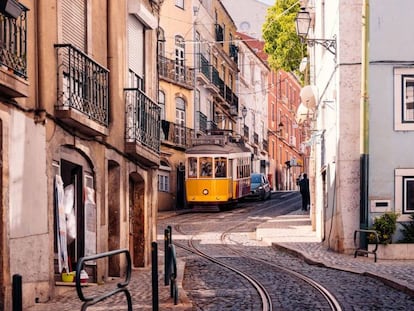La Arrábida, an inexplicably unknown paradise in Portugal
Charming towns, monasteries, castles, and beaches follow one another on a journey that runs through the heart of the Portuguese national park that ends at Casa Palmela, a 17th century manor house converted into a hotel

Winter 1963. A fragile, elegant-looking but prematurely aged woman drives through the green heart of the Arrábida Natural Park, about 30 miles south of Lisbon. At only 34 years old, she has crossed the Atlantic Ocean fleeing an unimaginable tragedy: the murder of her husband. Jacqueline Kennedy is seeking refuge, a hiding place away from the press and the weight of the history that has made her the 20th century’s most famous widow. It has been 60 years since that desperate escape, and we crossed the same hills through which the widow traveled to her Portuguese retreat. In the distance you can see the Palácio de Comenda, property of the Counts D’Armand, the friends who opened their five-story, 26-room residence so that Jackie could find a place of reflection and prayer, which is what the word “arrábida” means in its original Arabic.
During her isolation, Jackie walked among cork oaks, pine forests, and vineyards. We walk along a secluded beach (although her palace has one with private access) and travel along the road that winds through the natural park, dotted with noble houses that remind us that this was one of the summer resorts frequented by European royalty, like the descendants of the Irish O’Neill dynasty. From the top of the mountain range, Jackie could see the Castelo de São Jorge in Lisbon, the Castelo dos Mouros in Sintra, and the Castelo de Évora, three centuries-old strategic fortifications for the defense of Portugal. On the days in which her mood was most reflective, she would walk to the immaculate white village that stands out against the steep verdant hillside: the Monastery of Our Lady of Arrábida, founded in 1542 by the Franciscans.
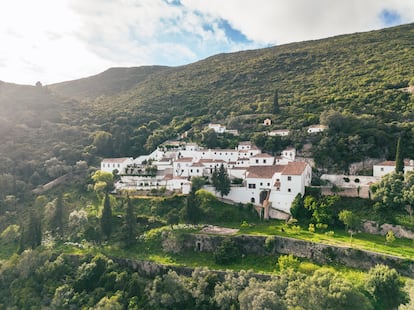
As it was then for Jackie Kennedy, the Arrábida mountain range is still a privileged refuge in the middle of nature. However, international and even local travelers have barely heard of it. How is that possible?
During our trip in search of an answer, we met an illustrious local resident. Salvador Holstein is a descendant of Bernardo Sousa and María Luisa Holstein, the Duke and Duchess of Palmela. Holstein explains that competition from the nearby city of Comporta has eclipsed interest in this other area, which is much less crowded, despite its proximity to the Portuguese capital. It will be he who will take us into these 10,000 hectares nestled between the Sado River and the Atlantic, in a perfect triangle bounded by the municipalities of Setúbal, Azeitão, and Palmela, as his family did with Jackie Kennedy six decades ago.
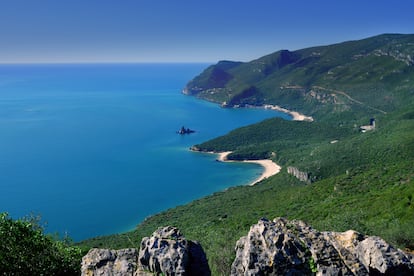
Mediterranean green, Atlantic blue
One one side, the path between cliffs through Portinho da Arrábida is home to some of the most diverse Mediterranean flora and fauna in the country. On the opposite side, a winding road, with narrow ascents and descents, overlooks the beaches where, in the summer, bathers can swim with a community of around thirty bottlenose dolphins. From above, it’s easy to understand why this last stretch of Portugal’s pristine coastline has sparked Sandra Ortega’s real estate ambitions. Inditex mogul Amancio Ortega’s first-born daughter wants to build a luxury hotel complex with more than 500 beds here, on the Tróia peninsula. For the moment, the environmental platform Dunas Livres has managed to stop the project, which would multiply the number of tourists on the spit of land next to the mouth of the Sado River.
Meanwhile, the Arrábida remains a relatively unknown spot, and this paradise of nature and sandy beaches stretches 25 miles from Tróia to Melides. For the modest price of a ride on by a small boat, you can enjoy beaches like Galapinhos almost alone. This sandy beach was chosen as the most beautiful in Europe, beating 280 other European beaches in a vote in which more than 130 countries participated. Nearby are also the beaches of Albarquel, Figueirinha, Galapos, Conejos, Creiro, Portinho da Arrábida, and Alpertuche. They are, at present, a luxury freely available to anyone.
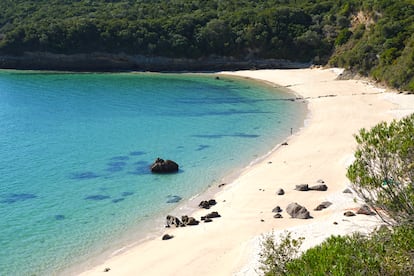
Route between towns
As we descend through the Portinho da Arrábida, Salvador Holstein’s car takes us to the part of town next the sea, where the best restaurants in the area are located. Among these are Farol, which serves fresh fish with views of the sea, and Galeão, whose menu allows you to savor the best of local cuisine along with the wines from the region that have been covered in vineyards for centuries. Local vineyards that produce high quality wines include José Maria da Fonseca, the oldest table winery in the country (1834), Quinta da Bacalhoa, and Quinta de Alcube.
Advancing through vineyards to the east of the mountain range you reach the Castelo da Palmela, almost 790 feet above sea level. It was originally a Muslim fortification dating from between the 8th and 9th centuries, and today is a national monument. From its tower it is easy to see Lisbon on clear days. Next to it, the Gothic church of Santiago de Palmela dates from the 15th century, and an old convent that these days is a pousada (high-class tourist hotel, usually found in beauty spots and often converted from castles or monasteries), from the network of Pousadas de Portugal, in the style of the Spanish Paradores.
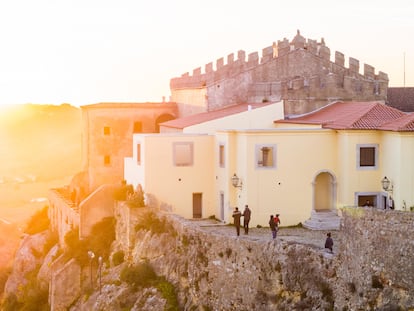
The descent from the castle allows you to embark on a route through some of the most picturesque towns in the area, such as Azeitão, at the foot of the mountains, where the sheep’s queijo and the fresh requijão cheeses are still made by hand. A walk through its cobbled streets also allows you to enjoy an unending supply of traditional pastries or visit the São Simão-Arte tile factory, one of the last producers of handmade tiles in Europe. The workers will patiently explain the entire manufacturing process, from baking to painting. Brush in hand, its artisans give life to the tiles that decorate buildings inside and outside of Portugal. If you ask nicely enough, they may reveal what Elton John asked for when decorating his bathroom with these Portuguese tiles. It is one of the few distractions in the town, in addition to the Harvest Festival or the medieval Saints Festival.
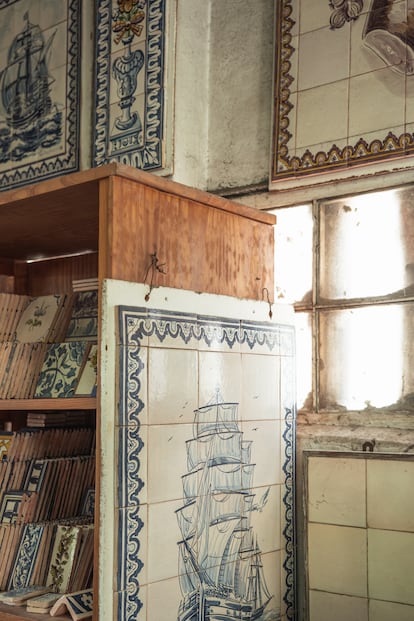
Casa Palmela, the heart of the park
Returning to the national park we arrive at Casa Palmela, Holstein’s estate, whose almost 175 acres have been in his family for two centuries. It is one of the few private properties within the national park, where construction has been prohibited since 1975. A 17th century manor house, classified as an Asset of Municipal Interest, has been converted into a 21-room hotel, surrounded by forest and vineyards of syrah and muscat grapes. Casa Palmela served as a summer residence for the São Francisco Xavier Jesuit College of Setúbal and today preserves part of the four-century-old stone floor, original furniture, 18th century tiles, and a small chapel.
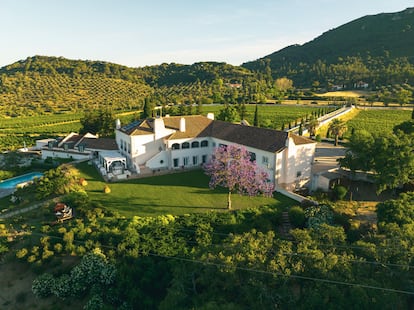
From the inside, the Jesuits’ refectory is a restaurant with a terrace, where you can enjoy clams à bulhão pato, cod cakes with tomato, or the traditional beef dish pica-pau. From the outside, the views from the hotel encourage you to take a walk through the mountains, on foot or on horseback, on a route that crosses paths and vineyards.
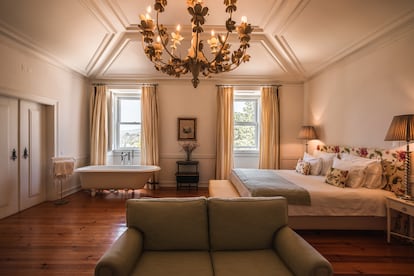
From here it is easy to organize boat trips, sunset yoga classes, or excursions to the cheese factories in nearby towns or the Mercado do Livramento de Setúbal, which supplies Casa Palmela. Early risers looking for fresh fish and travelers who want to get up close and personal with this fishing and agricultural market descend on this 19th-century institution, which USA Today recognized in 2015 as one of the best in the world. Once they have taken the obligatory photograph next to the large mural of 5,700 tiles that tells the life of fishermen and farmers, the travelers leave the market. Local life continues in this sleepy Portuguese paradise, far from the mass tourism of better known resorts.
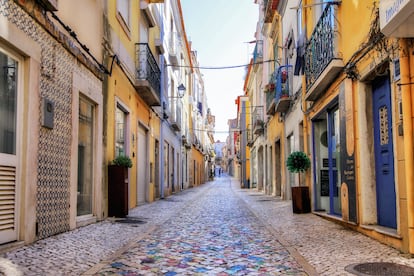
Sign up for our weekly newsletter to get more English-language news coverage from EL PAÍS USA Edition
Tu suscripción se está usando en otro dispositivo
¿Quieres añadir otro usuario a tu suscripción?
Si continúas leyendo en este dispositivo, no se podrá leer en el otro.
FlechaTu suscripción se está usando en otro dispositivo y solo puedes acceder a EL PAÍS desde un dispositivo a la vez.
Si quieres compartir tu cuenta, cambia tu suscripción a la modalidad Premium, así podrás añadir otro usuario. Cada uno accederá con su propia cuenta de email, lo que os permitirá personalizar vuestra experiencia en EL PAÍS.
¿Tienes una suscripción de empresa? Accede aquí para contratar más cuentas.
En el caso de no saber quién está usando tu cuenta, te recomendamos cambiar tu contraseña aquí.
Si decides continuar compartiendo tu cuenta, este mensaje se mostrará en tu dispositivo y en el de la otra persona que está usando tu cuenta de forma indefinida, afectando a tu experiencia de lectura. Puedes consultar aquí los términos y condiciones de la suscripción digital.
More information
Archived In
Últimas noticias
Most viewed
- Reinhard Genzel, Nobel laureate in physics: ‘One-minute videos will never give you the truth’
- Oona Chaplin: ‘I told James Cameron that I was living in a treehouse and starting a permaculture project with a friend’
- Pablo Escobar’s hippos: A serious environmental problem, 40 years on
- Charles Dubouloz, mountaineering star, retires at 36 with a farewell tour inspired by Walter Bonatti
- Why we lost the habit of sleeping in two segments and how that changed our sense of time

